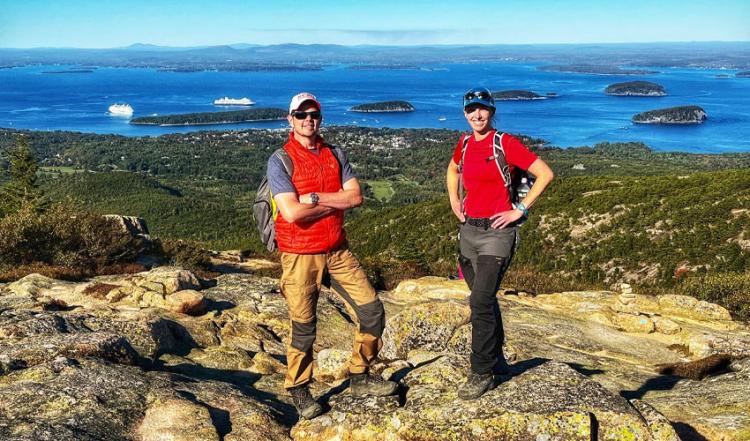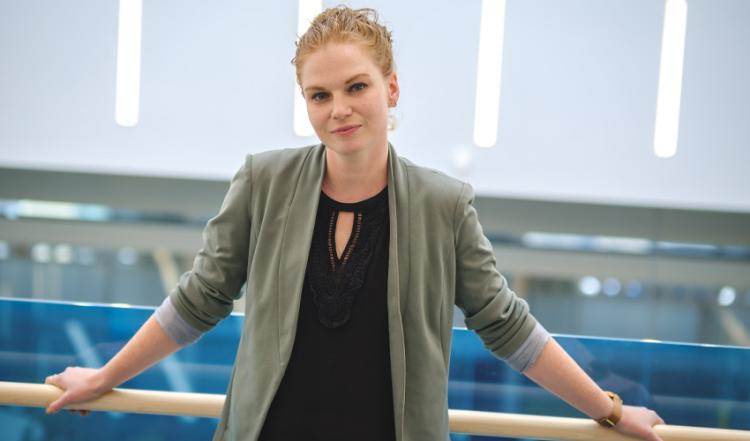By Peter Glenn
It's a 674-kilometre journey to the nearest stretch of sea, but Mount Royal University is riding a wave of ocean-related research. From discovering an ancient fish weir off the coast of Alaska, to examining supercontinents and their impacts on ocean chemistry, climate extremes and complex life on land, to climate change's effects on ocean species habitats, MRU faculty are exploring the secrets of the deep.
Ancient weir points to early Indigenous technology
The discovery of an 11,100-year-old fish weir on the west side of Alaska's Prince of Wales Island in Shakan Bay confirms the presence of people in the region at least 1,000 years earlier than previous evidence showing preserved archaeological sites on the seafloor suggests, and demonstrates that local Indigenous technology existed in the region.
Kelly Monteleone, PhD, a contract instructor in anthropology at MRU, led research confirming the presence of the weir approximately 52 metres below the surface. Used to harvest food, the weir was a low stone wall that would trap fish when the tide went out. Because it would only function in the intertidal zone, researchers used sea-level reconstruction to date the structure. It is the oldest confirmed weir, as others that may be older cannot be dated.

Kelly Monteleone, PhD, is part of a team that discovered an ancient weir off the coast of Alaska.
Monteleone's research tries to answer how and when people migrated to the Americas, focusing on the now-submerged continental shelf of southeast Alaska. The current project is funded by NOAA Ocean Exploration and Research.
"The key focus here is on the extension of Tlingit and Haida ancestors in the region to at least 11,100 years ago. My role is to help the local people better understand their past by providing technical support to access their history," Monteleone says.
"Also, 11,100 years old is very recent. We expect archaeological sites are underwater in the region dating to at least 16,000 years ago and possibly older. Sea level was significantly lower during the last glaciation, and people who came to the Americas would have inhabited the now-submerged coastline."
This is an ongoing research project for Monteleone. When she identified the weir on sonar in 2010, she was a graduate assistant and the weir was part of her dissertation research. The sonar discovery was published in 2019 as part of a British Archaeological Report International Series.
The discovery also fits into the "coastal migration model" that explains how people came to and moved throughout the Americas, Monteleone says. "Stone weirs like this one would be part of the marine harvest technologies that migrated along the coast."
Supercontinents and ocean chemistry
Meanwhile, Michelle DeWolfe, PhD, and Jeff Pollock PhD, professors in the Department of Earth and Environmental Sciences, are working with researchers in Canada and the U.S. on a project examining supercontinent formation and the resulting impacts on ocean chemistry, climate and life on land.
The Cambrian Age (540- to 485-million years ago) was a critical period in Earth's history that included the breakup of a supercontinent and was associated with extreme climate fluctuations between extensive glaciations and warm periods.

Jeff Pollock, PhD, and Michelle DeWolfe, PhD, are examining supercontinent formation.
DeWolfe and Pollock's research along the coast of Maine is focused on deciphering the geological history of a sequence of approximately 500-million-year-old volcanic rocks that formed in an ancient ocean called the Rheic. It analyzes the chemical and magnetic properties of these rocks in order to determine the past locations and motions of continents.
"We hypothesize that the closure and destruction of the Rheic Ocean was related to the assembly of all continents on Earth and had global ramifications," DeWolfe says. "It corresponds to extreme events that imposed new circulation regimes upon Earth's hydrosphere and atmosphere that had a profound impact on the planet's geological, biological and environmental cycles."
Geologists have long recognized that the processes related to supercontinent assembly and breakup take place, but recent studies have revealed that the impacts upon the Earth's long-term climate history are far more prevalent than previously thought.
"Figuring out the patterns and linkages between geologic, chemical and biological evolution some 500-million years ago is a grand scientific challenge that is critical because global paleogeography plays an important role in most explanations for the onset of metazoan life forms, mass extinctions and climate change," Pollock explains.
The project is funded by Mount Royal University in conjunction with collaborators from the University of Western Ontario and University of Maine.
"This work reinforces that geology is much more than petroleum exploration, a common misconception with potential students and the broader community," Pollock says.
"Research at Mount Royal is focused on study of the Earth, the materials of which it is made, the structure of those materials and the processes that act upon them."
Predicting future fish habitat
Finally, Sara Smith Wuitchik, PhD, is looking at more reliable ways to predict where ocean creatures can live in light of climate change.
Scientists use species distribution models to predict where organisms can survive. These models help guide conservation and management decisions, but may be unreliable when considering climate-change scenarios, as they often don't account for how species evolve in new environments.

Sara Smith Wuitchik, PhD, is researching ocean fish habitats in the context of climate change.
Smith, an assistant professor in the Department of Biology, uses field and lab experiments to determine traits that will be important for fish under climate change, including temperature-related physiology and behaviour, and whole genome sequencing to assess if there are genes associated with these traits.
"Combining temperature traits for different populations and population genetics, I incorporate these traits into new species distribution models in the Pacific Ocean to create predictions of where fishes may be able to live in the future under multiple climate-change projections," she explains. "These trait- and evolution-informed species distribution models should improve the accuracy of predicting where species can live in the future and help in applying new management policies for protecting biodiversity in our oceans."
Some areas of oceans surrounding Canada, for example, are projected to warm much faster than terrestrial landmasses, and many marine organisms rely on the temperature of their environment to control their body temperatures.
"As their environment changes, potentially at rates that they are unable to keep pace with, it's imperative for us to identify which populations or species may need focused conservation efforts," Smith says. "I hope that incorporating species- and population-specific data into our models will produce more realistic predictions of which populations need help as our climate continues to change."
Read more about Anthropology, Geology and Biology programs at Mount Royal University.










